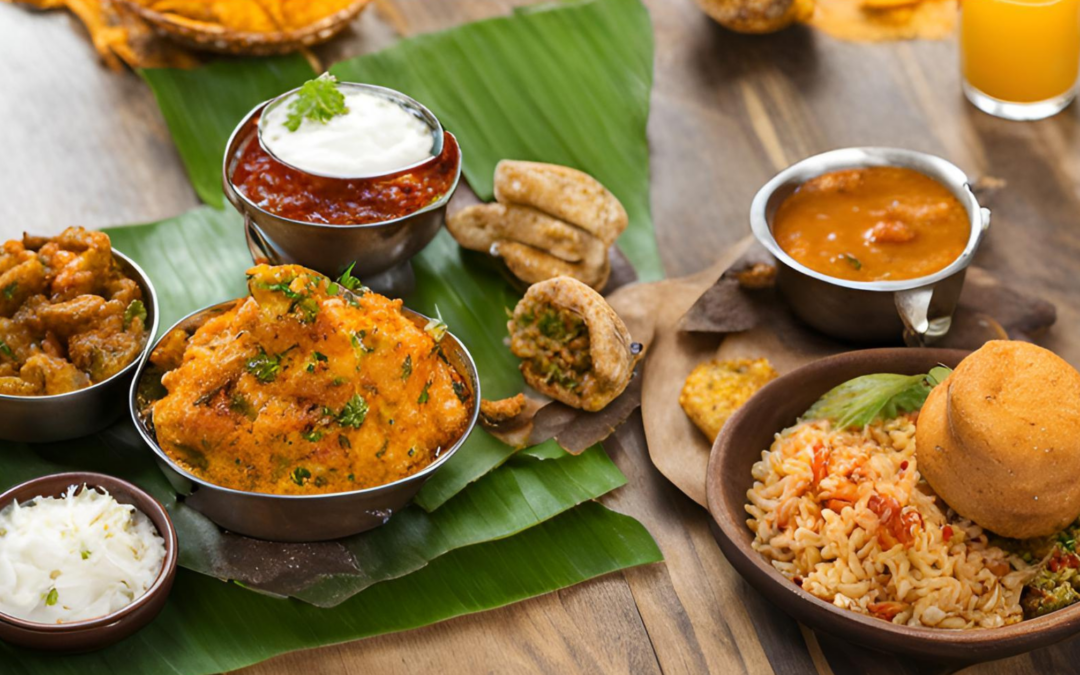North vs. South Indian Cuisine: What’s the Difference?
Indian cuisine is diverse, reflecting the country’s vast geography, history, and cultural influences. While North Indian cuisine is rich, creamy, and wheat-based, South Indian cuisine is known for its bold flavors, rice-based dishes, and extensive use of coconut.
If you’re wondering about the key differences between North and South Indian food, this guide explores their unique flavors, ingredients, cooking styles, and must-try dishes.
1. Core Ingredients: Wheat vs. Rice
One of the most significant differences between North Indian food and South Indian food lies in their staple grains.
- North Indian Cuisine: Primarily wheat-based, featuring roti, naan, and paratha as daily staples.
- South Indian Cuisine: Primarily rice-based, with dishes like dosa, idli, and steamed rice being the mainstay.
This difference is due to the geographical variations, where wheat thrives in the north, and rice flourishes in the south.
2. Flavors & Spices: Rich vs. Spicy
Both regions use a variety of spices, but the flavor profiles differ.
- North Indian Cuisine:
- Rich, creamy, and mildly spiced.
- Uses garam masala, cumin, coriander, and yogurt-based gravies.
- Popular for butter chicken, dal makhani, and paneer dishes.
- South Indian Cuisine:
- Spicier and tangier flavors.
- Uses curry leaves, mustard seeds, coconut, tamarind, and red chilies.
- Popular for sambar, rasam, and coconut-based curries.
3. Cooking Techniques: Tandoor vs. Fermentation
The cooking techniques further highlight the differences between North and South Indian food.
- North Indian Cooking:
- Tandoor-based cooking: Tandoori dishes like naan, kebabs, and tandoori chicken are popular.
- Slow-cooked curries and gravies enriched with cream and butter.
- South Indian Cooking:
- Fermentation-based dishes: Dosa, idli, and uttapam rely on a fermented rice-lentil batter.
- Steaming is commonly used in making idli and puttu.
4. Popular Dishes in North & South Indian Cuisine
Famous North Indian Dishes
✅ Butter Chicken – Creamy, tomato-based chicken curry.
✅ Paneer Butter Masala – Rich cottage cheese dish in butter-laden gravy.
✅ Aloo Paratha – Stuffed wheat flatbread served with yogurt and pickles.
✅ Chole Bhature – Spicy chickpea curry with deep-fried bread.
✅ Dal Makhani – Slow-cooked black lentils with butter and cream.
Famous South Indian Dishes
✅ Dosa – Crispy fermented rice-lentil crepe, served with sambar and chutney.
✅ Idli – Soft, steamed rice cakes paired with coconut chutney.
✅ Sambar – Lentil-based vegetable stew with tamarind and spices.
✅ Rasam – Tangy, peppery soup made with tamarind and tomatoes.
✅ Pongal – Savory rice dish cooked with lentils and black pepper.
5. Bread vs. Rice-Based Meals
A significant contrast in North vs. South Indian food is how meals are structured.
- North Indian meals are bread-based (naan, chapati, paratha) with rich curries and dry sabzis.
- South Indian meals focus on rice with different sides like sambar, rasam, curd rice, and coconut chutney.
Example:
- In the North, a meal may include naan with butter chicken.
- In the South, a typical meal could be steamed rice with sambar, rasam, and curd rice.
6. Influence of Dairy & Coconut
Another key difference is the use of dairy vs. coconut.
- North Indian food is dairy-heavy, using ghee, butter, cream, and yogurt for flavor and texture.
- South Indian food relies more on coconut in various forms—grated coconut, coconut milk, and coconut oil.
Example:
- North Indian gravies often use cream and butter (e.g., Paneer Butter Masala).
- South Indian curries use coconut milk (e.g., Kerala-style fish curry).
7. Use of Lentils & Vegetables
Lentils are common across India but are prepared differently:
- North Indian dal: Thick and buttery, with dishes like dal makhani.
- South Indian dal (sambar/rasam): Spicy and tangy, often cooked with tamarind and curry leaves.
Vegetables also vary:
- North uses potatoes, cauliflower, and paneer.
- South focuses on drumsticks, brinjal, and raw bananas.
8. Beverages & Desserts
Even drinks and sweets reflect the differences in North and South Indian cuisine.
Popular North Indian Beverages & Desserts
✅ Lassi – A yogurt-based drink, often flavored with mango or rose.
✅ Gulab Jamun – Fried milk-based sweets soaked in sugar syrup.
✅ Rabri – Thickened, sweetened milk with nuts.
Popular South Indian Beverages & Desserts
✅ Filter Coffee – Strong, aromatic coffee served with milk.
✅ Payasam – South Indian version of kheer, often made with jaggery.
✅ Mysore Pak – A rich, buttery dessert made with ghee and gram flour.
Final Comparison: North Indian vs. South Indian Cuisine
| Feature | North Indian Cuisine | South Indian Cuisine |
|---|---|---|
| Staple Food | Wheat (Roti, Naan) | Rice (Dosa, Idli) |
| Flavor Profile | Creamy, mild, rich | Spicy, tangy, coconut-based |
| Spices Used | Garam masala, cumin | Mustard seeds, curry leaves |
| Cooking Style | Tandoor, slow-cooking | Fermentation, steaming |
| Dairy Usage | High (Butter, ghee, cream) | Low (More coconut-based) |
| Famous Dishes | Butter Chicken, Dal Makhani, Naan | Dosa, Sambar, Rasam |
| Desserts | Gulab Jamun, Lassi | Payasam, Mysore Pak |
Conclusion: Which Cuisine is Better?
Both North Indian cuisine and South Indian cuisine have unique flavors, ingredients, and traditions.
- If you love rich, creamy curries and bread-based meals, North Indian food is for you.
- If you prefer light, tangy, and spicy rice-based dishes, South Indian food will be your favorite.
No matter which you choose, Indian cuisine offers a variety of delicious options that cater to every palate.

